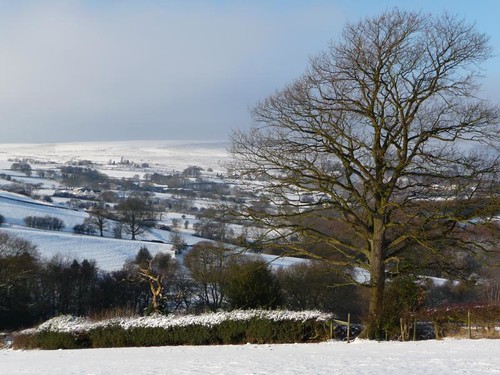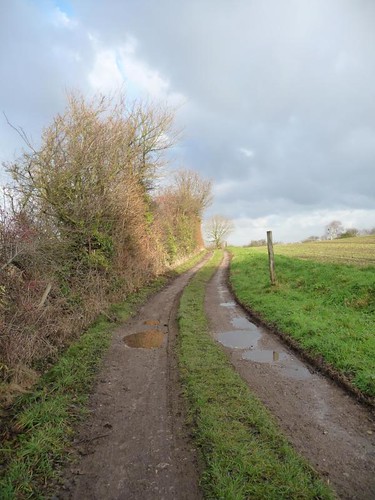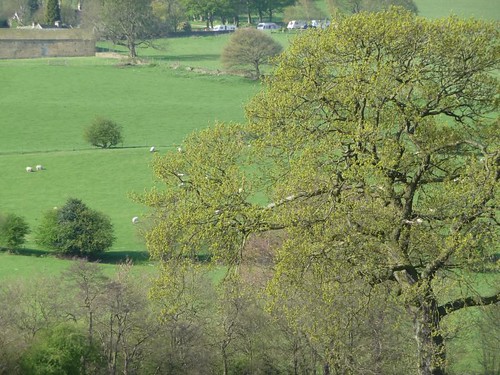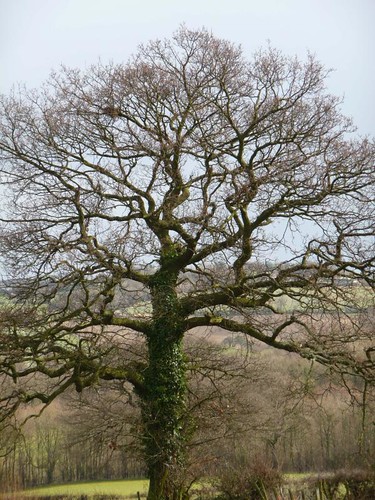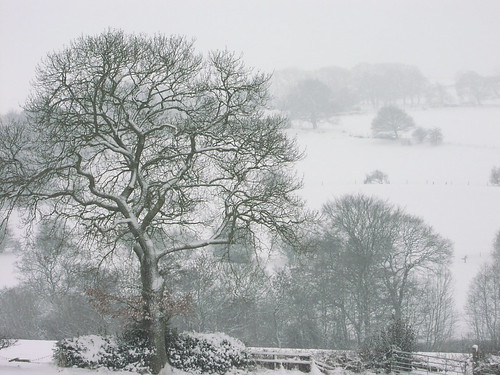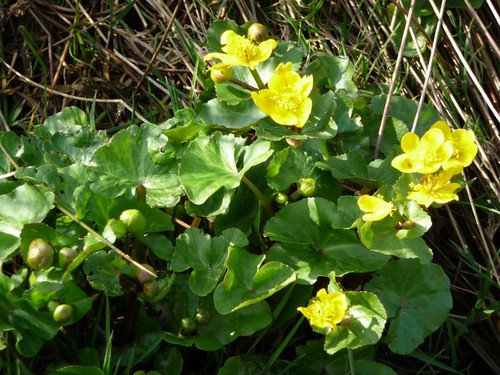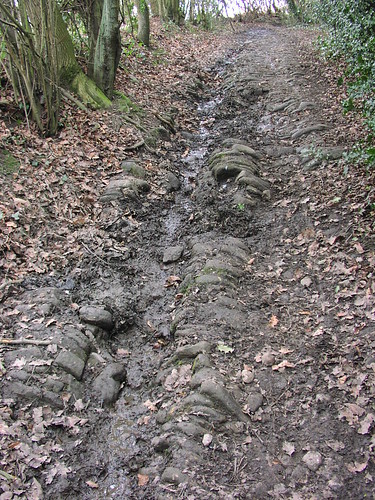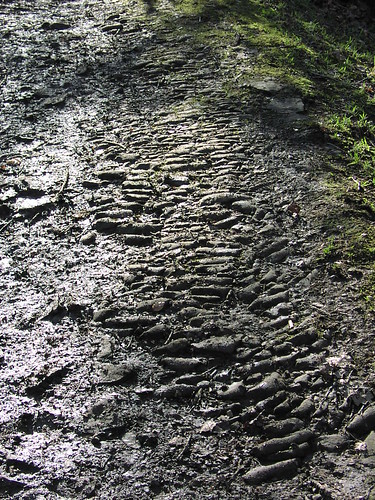Tuesday, 22 December 2009
John Donne and the shortest day...
'Tis the year's midnight, and it is the day's,
Lucy's, who scarce seven hours herself unmasks;
The sun is spent, and now his flasks
Send forth light squibs, no constant rays;
The whole world's sap is sunk;
The general balm the hydroptic earth hath drunk,
Whither, as to the bed's-feet, life is shrunk,
Dead and interred; yet all these seem to laugh,
Compared with me, who am their epitaph.
John Donne
Snow on snow...
Thursday, 17 December 2009
Maybe snow.....
Friday, 11 December 2009
Flytipping
Fieldfares
Emmonsails Heath in Winter
I love to see the old heath's withered brake
Mingle its crimpled leaves with furze and ling
While the old heron from the lonely lake
Starts slow and flaps his melancholy wing
And oddling crow in idle motions swing
On the half rotten ash tree's topmost twig
Beside whose trunk the gypsy makes his bed -
Up flies the bouncing woodcock from the brig
Where a black quagmire quakes beneath the tread;
The fieldfare chatters in the whistling thorn
And for the 'awe round fields and closen rove,
And coy bumbarrels twenty in a drove
Flit down the hedgerows in the frozen plain
And hang on little twigs and start again.
"Crimpled," "oddling" "bouncing woodcock" - what words! What a naturalist as well as a poet! Some of Clare's poems protest the harm wrought by the enclosure of the commons that he witnessed in his lifetime. We are enclosing our world with heat not fences and hedges. Will our winters ever be the same?
Tuesday, 30 June 2009
Lights Out!
We won! We got rid of the terrible lights! People said it couldn't be done but we did. Yesterday I spoke again at the Council Planning Board. Council at last voted to remove them! We had some mightily damning evidence (see speech and appendix below) and the Head of Transport and Planning didn't know where to put himself. I wonder if he will keep his job?
Can't wait to see the landscape back to its old self.
This is a victory for the environment. Thanks to all those who helped in whatever way - you know who you are. Here is the speech and eveidence in an appendix (not sure how to link to this, so it is here in full).
We, in common with others who love Sheffield’s unique situation next to the Peak Park, are concerned about the urbanisation of the city’s rural fringes within the green belt. These street lights erected in countryside, near open SSSI moorland on Totley Moss and Blacka Moor are huge, closely spaced, marching along the beautiful Baslow Road out towards Owler Bar for about ½ mile. By day they scar this road and by night they pollute the night skies and can be seen from high ground all around, including from within the Peak Park itself. Reducing the wattage and painting the standards grey is not enough.
The lights have been erected in connection with a new 30mph zone out of the city, in turn connected with understandable safety concerns about the new 97 bus terminus and the emergence of buses onto the main road. Many people believe this to be entirely the wrong solution - not only visually, but in terms of road safety. It has made the road more dangerous – there is tailgating and overtaking as never before. This situation has resulted from an appalling catalogue of errors from start to finish and this continues to be the case, even with this latest report.
Firstly, with sensible discussion with the landlord, Enterprise Inns, First buses and SYPTE, it should not have been necessary to move the bus terminus from its site outside the Cross Scythes pub in the first place. The present and indeed past landlord had no objection to the buses turning there providing drivers turn off engines. Enterprise Inns were also open to negotiation. The present terminus is extremely costly and wasteful of energy.
Having decided to move the terminus out of the city to the end of Gillfield Wood and having erected the new lighting, Officers did not consult the Peak Park - as they should have under Section 62 of the Environment Act. Only when SPACE pointed this out and under pressure from the Peak Park Authority, did they meet – a meeting likened by one of the senior planners at the Peak Park Authority to an episode of Fawlty Towers.
The lights and speed limits were put in place after informal advice only – and very unclear advice at that – from Road Safety Officers. A proper Road Safety Audit was not completed until after the lights were erected and this merely tinkered with the existing new scheme. The lights were erected before the plans for the turning circle were passed by this Board. Similarly, the new 40mph buffer zone was instituted before it was passed by this Board. When SPACE pointed this out, 40mph signs had to be covered up! There were yet more minor errors – too numerous to mention here.
Now, to today’s report by John Bann, Director of Transport and Highways. Nearly every calculation and statistic justifying a speed limit of 30mph and the lighting after the event is wrong. And not only wrong, but shockingly and outrageously wrong. The sightline towards Totley is actually 3 times as long as their calculations - at 350 metres. The 30 mph zone is 4 times as long - 800 metres, not 200 metres. 7 of the 8 reportable accidents referred to happened in 2000 and 2001 before safety measures - chevrons and crash barriers - were put in place in November 2001. The sole reportable accident since that date was not due to losing control on bends. (Please see more about all these factual details in the Appendix). This 30 mph limit has resulted in frustrated drivers, tailgating and attempted overtaking as well as the terrible visual intrusion of the light standards and the lights themselves.
Although errors have been made at the lowest technical level, to our minds, the greater blame should be attached to those who took their eyes off the wider picture, particularly the need to consider visual and light pollution in the green belt of a city renowned for its marvellous countryside and its proximity to the Peak National Park.
We believe that this board should:
1. Question the competence of its officers throughout – for lack of proper procedure, for misleading the public, and for lack of basic ability in technical matters.
2. Reprimand these officers for using incorrect, misleading or unclear information and reports to justify the speed limit and lights after the event. Old accident statistics have also been used to justify these when road safety has since been vastly improved by other measures.
3. Reprimand Officers for lack of proper consultation. Many were shocked because it was unclear from public consultation that the lights would be a consequence of the new terminus. No consultation was carried out with the Peak Park Authority as it should have been according to the Environment Act.
4. Remove these appalling lights, apart from immediately around the terminus itself.
5. Institute a speed limit of 40mph all the way from Owler Bar (at present it is still 60 mph there) down to the junction with Lane Head Road and the first Totley houses. This is well within recommended safety guidelines for such a situation and actually safer than the present mix of 60, 40 and 30mph from Owler Bar and into Totley.
6. Enforce and encourage the 30 mph speed limit more effectively in Totley itself.
We have support for our campaign against the lights from many individuals, from CPRE, the Campaign for Dark Skies, local residents’ and wildlife organisations and officers from the Peak District National Park. They are creeping urbanisation at their worst and destroy the progression from country to city and back again - such a special thing in this wonderful green city of ours.
Appendix : The damning evidence
Much of the evidence in this is due to the expertise of 2 ex engineers in our group - thanks to Peter Stubbs and Duncan Froggatt.
APPENDIX: SPACE response to the Report by Director of Transport and Highways
30mph and lighting?
There is no need for the road between Totley and the new terminus to be subjected to a 30mph speed limit or to be lit. In his informal advice, the Road Safety Officer merely advised that the road should “ideally” be lit. We agree that there should be some lighting of an appropriate kind adjacent to the terminus itself.
However, having decided to install lighting right along the road in the open country to just beyond the terminus, Mr Bann’s officers are claiming that this is necessary together with the associated 30mph speed limit because of restricted sight lines. Their calculations relating to the need to have a 30mph limit and associated lighting are utterly and shockingly wrong. Here is paragraph 3.1 from his report (our bold type):
- The bus terminus scheme proposals required the provision of a 30mph speed limit in the vicinity of the access/egress to the bus turning area. This was required to comply with safe visibility conditions. The maximum sight line out of the bus turning area is 111 metres. The design criteria guidance used by the Council (and endorsed by the Department for Transport) states that sight lines under 120 metres require a 30 mph speed limit. In order to slow down traffic approaching the site from Derbyshire, a 40 mph buffer zone was proposed and approved by Board in February 2009.
The maximum sightlines (as measured by 3 members, 2 of whom are retired engineers) are:
- approximately 350 metres from bus turning area North East towards Totley and the severe bends.
- approximately 180 – 200 metres from bus turning area South West towards Derbyshire and the bend before Dyson’s Brickworks
So – Mr Bann’s department have measured the maximum sightline towards Totley at approximately a third the length of its actual measurement and used this to justify the 30 mph limit. The correct sightline length actually complies with a design speed of 50 mph (DfT and Council design criteria). 30 mph is unsafe – hardly anyone sticks to it, it feels unnatural and there is now a lot of tailgating and attempts to overtake. Many Totley people feel that, erring on the safe side, considering the gradient, the emerging buses and the severity of the bends, the limit should be 40mph. This is an achievable, enforceable, sensible speed, well within the guidelines, considerably reduced from the previous national limit of 60mph.
Even the sightline towards the bend before the Brickworks is almost twice as long as Mr Bann’s “maximum sightline.” This is mostly within the new 40mph “buffer Zone” - an appropriate limit we feel (although wrongly measured).
There are yet more outrageous errors in calculation and logic in the next paragraph (again – our bold text):
- There is no Speed Limit Order (SLO) for the 30mph restriction on the newly lit length of road. Under national legislation, if street lighting is introduced on a previously unlit road, then that road is automatically subject to a 30mph restriction. A SLO need only be made if the Highway Authority wishes to introduce a speed limit in excess of 30mph. The minimum length of road covered by a speed limit is 600 metres. The length of road between the recently introduced 30 mph speed limit at the bus turning area entrance/egress and the existing 30 mph limit at Lane Head Road is approx 200 metres. This means that there is insufficient road length to change the speed limit to 40mph between the bus turning area and the existing 30mph speed limit at Lane Head Road.
The length of road between the existing 30 mph at Lane Head Road and the bus turning area is approximately 800 metres – 4 times Mr Bann’s calculation and 200 metres longer than the minimum length needed. Even so, this is nonsense - we would have thought that this length of road could just be added to the new 40mph zone as it is contiguous with it?
Surely the most basic qualities of an engineer should be the ability to measure correctly? Maybe the errors have occurred because the distances were not measured on site but scaled from a map and the wrong scale used?
Para 3.3 of the report refers to the reportable accident record on this stretch of road. Of these 8 accidents, all apart from one, occurred in 2000 and 2001 and occurred because drivers lost control on the bends. In November 2001, chevrons and crash barriers were erected – probably the reason why accidents were reduced. The only one since this date – in 2006 – occurred because “the driver took his eyes off road for a split second and crashed into a wall.” So, accidents have been much reduced and it is doubtful whether lighting will now make much difference. Indeed, section 1.2.4.1 of DfT Road Safety Research Report No 100 (Nov 2008) points out that “improving lighting has been shown to result in higher vehicle speed”, so the situation could actually be worsened.
Wednesday, 24 June 2009
Craig: The Story of a Dog
Monday, 11 May 2009
Blackcaps and briony
On Fanshawe Gate Lane the hedgerow is twined with tall twists of briony:

On the way back, we talk about the peasant poet John Clare and his deep emotional connection with the landscape in which he lived - to the extent that he became ill when moving only 3 miles from it. Judith went on to talk about what the government call "placemaking" and how they have sort of co-opted this idea of emotional connection with place as a way in to "consultation" with local people. Although this can be good in many ways, she feels that it is often shallow and a distraction from the more deep rooted issues. A bit like Tesco stocking organic veg I suppose.
Monday, 4 May 2009
Welcome in the May - o!

May Day photos: blackthorn over but the hawthorn - or may- about to burst.
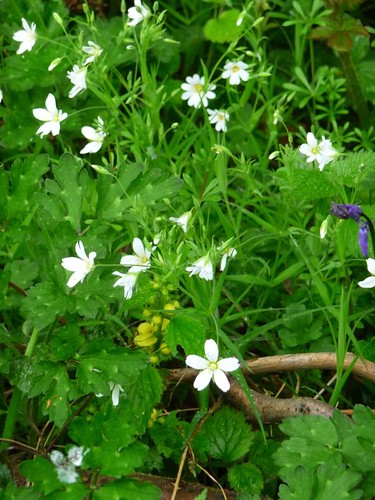
Stitchwort or Poor Man's Buttonhole around Gillfield...
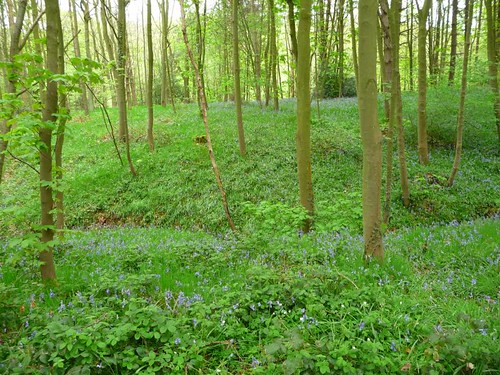
.....and the blue smoke of bluebells in the Wood.
Chiffchaffs and warblers singing, swallows swerving in the fields, blackbirds on every tree and satellite dish. Barbara says there is one near her (or maybe it's a thrush?) on Greenoak Road that she is sure keeps singing "Mary Joby, Mary Joby" - the name of an old lady who used to live there.
Tuesday, 28 April 2009
Blacka Moor
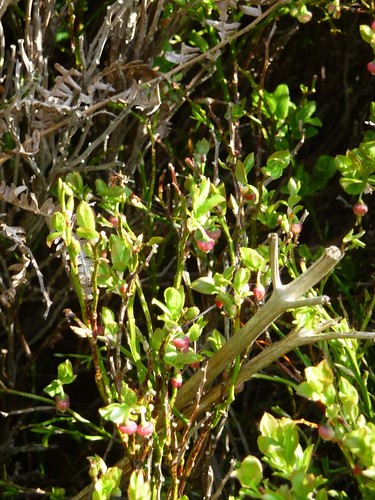
We had a little walk up on Blacka last week and found the bilberries in flower. Here's a reminder to check out Neil, the Blacka Blogger's site where he talks about these. He also posts wonderful pictures of the deer up there - natural grazers, not like the heavy footed Highland Cattle that have been introduced, he says. It is quite magical the way the deer have made Blacka their home. I've not been early enough, quiet enough (with a partner and dog) or sharp eyed enough to spot them yet. But almost every day Neil finds them and is learning more about them.
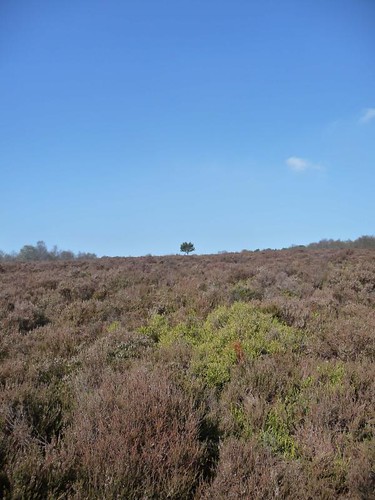
Monday, 27 April 2009
Long live the weeds and the wilderness yet.....
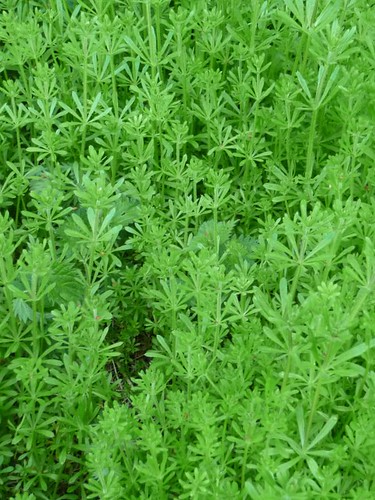
Spring flowers and plants appear daily. I can't keep track. Here are some sticky green cleavers or goosegrass near the farm at the footpath down from Mickley to Totley. We used to stick them on each other's backs as kids.
Violets in banks - at the top of White Lane and along Fanshawegate Lane. Hedge garlic, young nettles are everywhere and bright wood sorrell - along Brindwoodgate near Great Brind Wood beyond Cartledge - make some "food for free". The bluebells are out - but not quite at their best yet. Bugle near the Scout Hut. Lots of Dog Mercury for weeks and weeks now. The cow parsley (we used to call it kek in rural Oxfordshire) will soon be frothing up along the lanes. Stitchwort (or Poor Man's Buttons) in Ladies Spring Wood above Dore and Totley Station and the railway line.
Following the holloway

Near Rowan Tree Dell - note old fallen post in water
I have mentioned the old holloway (ancient trade route) before - the one that ran from Dore down through Totley and the Cordwell Valley to the Roman Road of Rumbling Street (so called because carts rumbled along it).
Christine and I recently took a pair of secateurs and explored the part no longer used between White Lane and Rowan Tree Dell and across to where it joins Totley Hall Lane (see photo above). Most of it still exists though sometimes still as roads, sometimes as paths. Old Hay Lane in Dore was part of it as was Totley Hall Lane. Many people will remember the deep sides of Totley Hall Lane towards the fields before the new estate of houses was built near the Hall. By a detective process and close observation over the months, I worked out that it then went along the bottom end of the recreation ground next to these houses and through the gardens of Rowan Tree Dell, then down to ford the Totley Brook and across a field to join up with the part that is still a footpath veering off White Lane up to Woodthorpe Hall. It then went along Fanshawegate Lane, up the deep magical east side of Holmesfield Park Wood (known as Hob Lane - perhaps due to a few hobgoblins"), then either along Grimsell Lane to Millthorpe (just off Horsleygate Lane)and down another section - I think called Pingle Lane - to Rumbling Street. And perhaps even beyond to Oxton Rakes - although I haven't explored that part yet. Here are some photos following it on my flickr site.
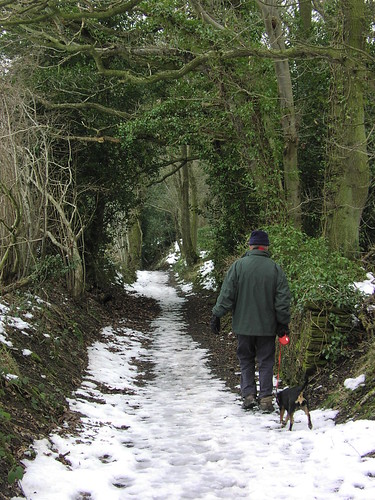
Hob Lane in the snow
David Hey gave a marvellous old fashioned talk on packhorse routes to Totley History Group last week. His book about these is a must if you want to find out about them.
Greening up
Derbyshire squeezers

I've been trying to pull together a little collection of photographs of local Derbyshire squeezer stiles - even if they are now in Yorkshire! See the set so far on my Flickr site.
Brian Edwards has a little article about them in this month's Totley Independent. He says that in some places they are known as "Fat Man's Agony."
There are some gates too. Here's a lovely old metal kissing gate at Woodthorpe.
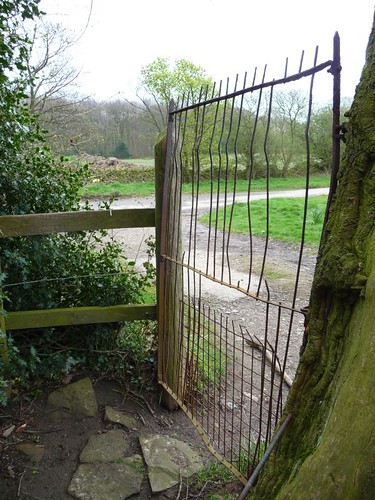
Saturday, 25 April 2009
Wood anemones

These pink wood anemones delighted me this week. Here is John Clare, the peasant poet (1793 - 1864):
Sonnet: Wood Anemone
The wood anemone through dead oak leaves
And in the thickest woods now blooms anew,
And where the green briar and the bramble weaves
Thick clumps o'green, anemones thicker grew,
And weeping flowers in thousands pearled in dew
People the woods and brakes, hid hollows there,
White,yellow and purple-hued the wide wood through.
What pretty drooping weeping flowers they are:
The clipt-frilled leaves, the slender stalk they bear
On which the drooping flower hangs weeping dew,
How beautiful through April time and May
The woods look, filled with wild anemone;
And every little spinney now looks gay
With flowers mid brushwood and the huge oak tree.
Monday, 13 April 2009
Spring has sprung....

Spring has properly arrived at Fanshawegate. Their garden open days are lovely - one at the end of the month I think.
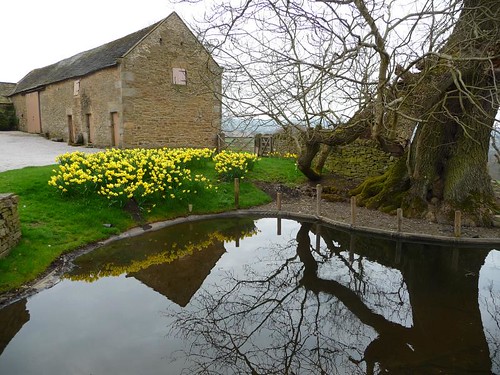
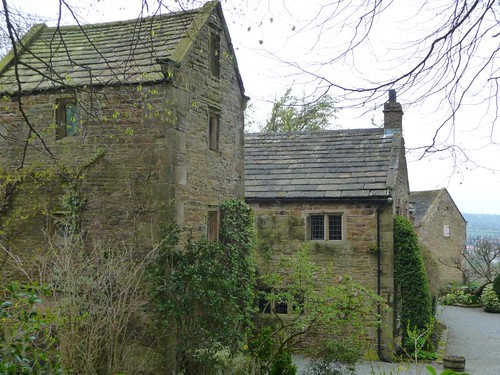
Violets on the lane...
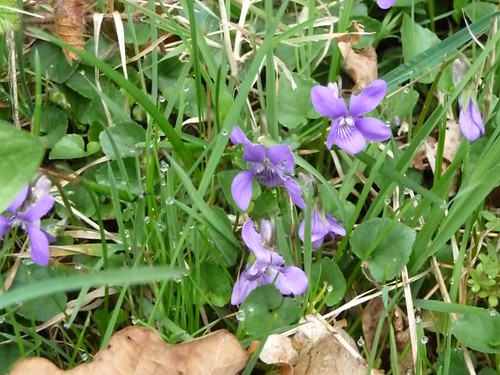
Lots of bird activity - a pair of nuthatches on a chimney pot on Aldam Road, goldfinches and greenfinches at Fanshawegate, sounds of goldcrests at Woodthorpe.
Saturday, 11 April 2009
New kids on the block
Another photograph of the wood anenomes (anenome nemorosa) which drift over Gillfield Woods - blooming for a few weeks now. They only fully open in the sun and take advantage time-wise of the light before the leaves are on the trees.
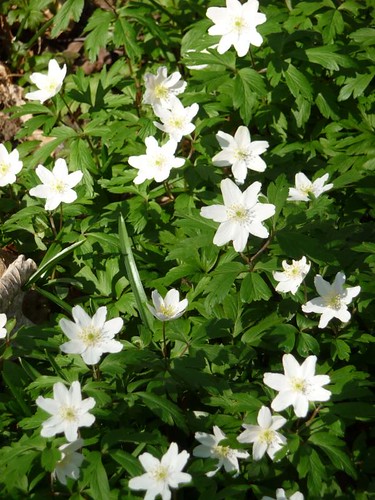
Out of the woods and across the fields to Totley Hall Lane, I spotted some blue wood anenomes - possibly a garden escape now naturalised? Anyone know?
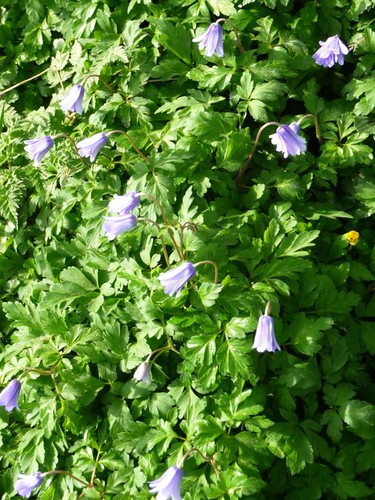
In the fields of Totley hall farm I also heard the kew-wick of a kestrel and spotted it in a tree...
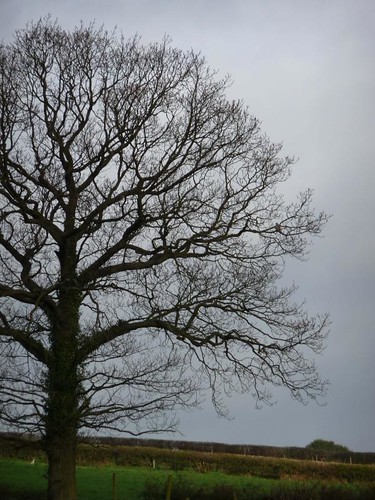
Chris the expert bird spotter say there are little owls. Both he and another neighbour have also seen a buzzard. Need to get out and check for warblers. Even swallows....
Down near the Shepley Spitfire on White Lane I looked for signs of the Lords and Ladies (many ruder names but we always knew it as Cuckoo Pint - to rhyme with mint - possibly being a word like pistle - you can guess what that is). Here they are - more photos to come, hopefully, of its ruder manifestations as the seasons progress.

And a lovely and very friendly young beastie has joined the sheep below St George's Farm.

Sunday, 29 March 2009
Oaking around

The "ley" in the name Totley, denotes a place of cleared woodland. Two days ago I spent the morning photographing the ancient oaks in the fields around Totley Hall Farm. According to countryside and woodland history expert Oliver Rackham, oaks are no longer able to seed themselves easily in woodland as the American fungus dieases all oaks are now prey to seems to affect their ability to regenerate in woods, but does not affect them in the open. So I suppose this means the English oaks in woods will die out at some point. But what about these trees in field boundaries, presumably the remnants or assarts of the ancient cleared woodland? Should we be collecting their acorns and sowing them, protecting them from grazing by sheep? Should we be talking to the Woodland Trust (some of whose small planted trees were taken down for the new bus terminus at the end of Gillfield Wood)?
These oaks are old, venerable, each very much an individual. I feel rather humbled in their presence.
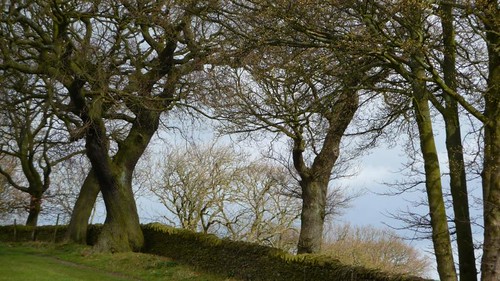
Of course, much of Gillfield Wood, an ancient wood, was chopped down in the 1950's and replanted with commercial American oak. So these field boundary oaks are the legacy of the older wood. Luckily the replanting hasn't seemed to affect the wonderful woodland plants too much - looking forward to the bluebells and right now the wood anenomes are delicately delightful.
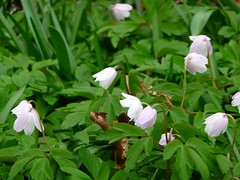
Thursday, 26 March 2009
Birds eye primrose?
Wednesday, 25 March 2009
Spring Equinox
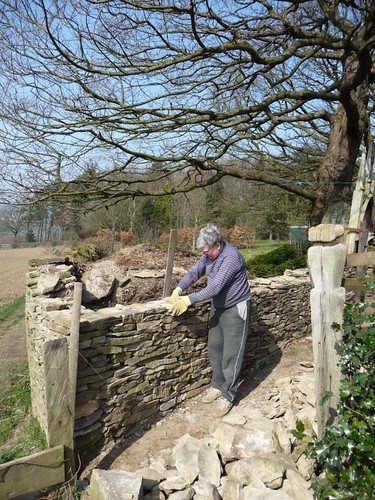
Stonewalling at Woodthorpe on 21st - and marvellous it is too. They are also going to replace the mock Gothic gate that hung here. You can see another at the back. I think they were made by a previous Shepley sometime early in the twentieth century but I can't remember where I read this. I hope they are as lovely.
Chiffchaffs are heralding the Spring.
Thursday, 19 March 2009
Back again...
However - the big news is that I have won quite a major poetry competition - one of 4 winners in the Poetry Business pamphlet competition judged by Michael Longley. So I will get a pamphlet of poems published. I am over the moon....
Here, together with a photo from yesterday's walk, is a poem which will be in the pamphlet:

The holloway
Duck, and you’re fed inside
this oak-soaked dark -
a gullet carved from wildwood where
a pheasant’s broken clockwork startles.
You’re breathed in.
Only rattled blackbirds breach
the arched green hush
where banks are mossed.
Soft earth, hard stone,
leaf-litter, flesh the floor,
and still you are flowed, a boat,
runnelled and cundy borne,
away from heat that frets
in a future - not of your choosing,
yet somehow of your making.
Monday, 23 February 2009
From Yorkshire into Derbyshire and back....
 Most days, on our "default" walk, we walk out of Yorkshire into Derbyshire and back again. This, on the White Lane, is the culvert (which collapsed last year) for a little stream which runs into the Totley Brook. This side is Derbyshire, the other side, with Maisie the dog, is Yorkshire. However, until 1935, Totley was in Derbyshire. Then the stream would have marked the boundary between Totley and Bradway. Quite why the boundary followed this little stream as far as here, rather than the Totley Brook, is unknowable, although Brian Edwards, the real expert on Totley history, thinks it may have arisen from an exchange of land in 1280.....
Most days, on our "default" walk, we walk out of Yorkshire into Derbyshire and back again. This, on the White Lane, is the culvert (which collapsed last year) for a little stream which runs into the Totley Brook. This side is Derbyshire, the other side, with Maisie the dog, is Yorkshire. However, until 1935, Totley was in Derbyshire. Then the stream would have marked the boundary between Totley and Bradway. Quite why the boundary followed this little stream as far as here, rather than the Totley Brook, is unknowable, although Brian Edwards, the real expert on Totley history, thinks it may have arisen from an exchange of land in 1280..... Here, outside the flats on Greenoak Road, is the first daffodil I have spotted this year. Its a lovely little border here, kept pretty by one of the residents.
Here, outside the flats on Greenoak Road, is the first daffodil I have spotted this year. Its a lovely little border here, kept pretty by one of the residents.
Sunday, 22 February 2009
Hi ho for Spring....

Wednesday, 18 February 2009
Diggers...


 This is the new bus terminus under construction, next to the terrible lights....
This is the new bus terminus under construction, next to the terrible lights.... 
This is at the end of the footpath through the wood - described by Cllr Peter Price in his wonderful 45 mile round Sheffield walk "The Sheffield Way" as "a very pleasant footpath through an extremely attractive peaceful wood." Cllr Peter Price voted for these lights.
Tuesday, 17 February 2009
Gobbledegook

Sunday, 15 February 2009
Saturday, 14 February 2009
A Greenoak Valentine

A present this morning by the flats on Greenoak Road - the first crocuses emerge from under the melting. The rooks are starting to mend their nests.
 We climb up to Holmesfield and along to the field above Hob Lane.
We climb up to Holmesfield and along to the field above Hob Lane. Hob Lane is part of the ancient track running from Dore (Hillfoot), to Totley Lane, Woodthorpe, Holmesfield, Millthorpe, and south to Rumbling Street (a reputedly Roman Road so named from the ancient carts that used to rumble along it).
Hob Lane is part of the ancient track running from Dore (Hillfoot), to Totley Lane, Woodthorpe, Holmesfield, Millthorpe, and south to Rumbling Street (a reputedly Roman Road so named from the ancient carts that used to rumble along it).We slither back via Fanshawegate into Gillfield Wood. Only the odd jackdaw chips at the silence.

